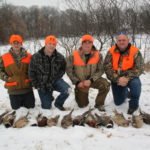I had the weekend to myself. After three straight weekends of pheasant and deer hunting, my partner had to take a break and go to work. Since neither of us had yet killed a buck, venison was on my mind. Hunting alone presents a challenge: getting the deer you kill out of the woods. With some snow on the ground to make the pulling easier, I was up to the task and looking forward to some serious hunting.
It was snowing Friday morning when I went out for a couple of hours before heading to work. Tracks were few in the silent forest. I wondered if wolves had chased the deer away. Sneaking along, I heard a faint sound behind me and turned to see a large wolf bounding away. That a wolf could approach so close unbeknownst to me was startling. Evidently, it decided a guy with a rifle wasn’t good to eat. Thinking there would be no deer nearby, I picked up the pace and started walking. Within 100 yards I jumped a doe and fawn that were meandering and feeding in heavy cover. So much for my theories about wolf/deer interactions.
The snow was over Saturday morning. Deer were on the move. I encountered six of them within a quarter mile of sneaking along; a doe that walked up to me, a doe with two fawns, another doe that ghosted through the brush and a nice buck that saw me first. As for what happened next, don’t ask. The flurry of whitetail action led me to believe it wouldn’t be long before I found another buck. It seemed like I couldn’t walk 50 feet without coming upon more fresh deer tracks. In the afternoon, despite all the fresh sign, I realized the deer were no longer active. I finished the day in a place where a lonely buck had wandered back and forth that morning. He was no longer there.
On Sunday, I packed a lunch, determined to stay in the woods until I killed a buck. That I did not pack a sleeping bag may suggest I was confident the task would be accomplished before day’s end. More to the point, carrying lunch put me in the proper frame of mind to find a buck.
It was snowing at daybreak. Fresh deer tracks were few and far between. While stand hunters sit and wait for deer to come to them, a still hunter sneaks through the forest to go where the deer are. Fresh snow cover offers the still hunter an obvious advantage. When you find tracks, you know the deer that made them isn’t far away. The lack of fresh sign wasn’t discouraging, because I knew there were deer in the vicinity.
Playing the long game, I just hunted. By lunchtime, I was more than a mile into the woods and still seeking fresh tracks, aside from some left by a very busy marten. Finishing my cold hot dog, I decided to just start walking until I found some deer sign. It took a hike of better than a quarter mile to run across the tracks of a doe and fawn. Then I shifted into hunting mode.
A lot of hunters think that still hunting is mostly about slowly walking through the woods. Successful still hunters know you spend most of your time motionless rather than in motion. The trick is to become aware of a deer before it is aware of you. Whitetails are always pausing to look, listen and test the breeze. It takes some doing on a hunter’s part to beat that wondrous array of senses.
So, you take a few steps and then stop, preferably near a tree that will break up your outline. Then you watch and listen, paying particular attention to the periphery of your field of view. Only when you are satisfied there is nothing within or just beyond your periphery do you take a few more steps. A still hunter assumes deer are nearby and acts accordingly.
I wasn’t hunting for the doe and fawn that left the tracks, but for the buck that was likely in the vicinity. Then I happened upon the tracks of other hunters: two or three wolves that were stepping into one another’s footprints. This was fortuitous, because it was now afternoon and I was a long way from where I started out at daybreak. I decided to make a course correction to swing away from the wolves and begin a long circle back toward my starting point. Once again, I picked up the pace, walking a couple of hundred yards. This time I happened upon ‘smoking’ fresh buck tracks. Knowing he wasn’t far away, I slowed to hunting speed, thinking the buck might become aware of my presence and check me out, not knowing that I was a hunter. Northwoods whitetails do this more often than you may think.
Minutes later I heard a soft sound and caught a flicker of motion through the woods. It was a buck, coming from the direction the fresh tracks had led. He was fairly far off, better than 40 yards, and too screened by trees and brush to offer a shot. I picked out an opening in the cover where he would pass and slipped off the rifle’s safety. Perhaps noticing my movement, the buck paused just before he reached the opening. Putting the crosshairs on him, I found an open shot at his vitals. I squeezed the trigger.
The buck didn’t drop, but he appeared to be wounded. He slowly walked, trotted and briefly stopped, allowing me to fire three more times before he disappeared from view. Walking to where I last saw the buck, I picked up his tracks. There was no blood. Following the deer, I finally saw a tiny speck of red in a hoof print. Another 50 yards along the track, I found another tiny speck and, eventually, a single drop of blood. Now I had followed the tracks for more than 150 yards and was wondering what was going on. Then I came upon the buck lying dead in the snow.
Field dressing revealed the first bullet penetrated one lung and passed entirely through the deer. I missed the other shots. The body cavity was full of blood, but the animal hadn’t bled through the entrance and exit wounds. Without snow, I’m not sure I would have found the deer. This isn’t the first time I killed a deer that didn’t leave a blood trail.
It was 1:30 when I pulled out my knife and went to work. GPS indicated I was about two miles from my starting point. I dragged the deer about 300 yards until I reached a white pine that was a familiar landmark. Then I walked out to get the toboggan we use to haul deer. I had the deer tied into the sled at 4:45 and, after a nice evening walk, reached the truck at 6:45. I was a little tired and a lot satisfied. It was a great weekend.




